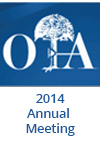
OTA 2014: High-dose vitamin D vs. placebo in deficient patients with long bone fracture .
The Effect of Acute High-Dose Vitamin D Supplementation on Fracture Union in Patients With Hypovitaminosis D: A Pilot Study
89 of 102 enrolled patients with long bone fracture were identified as vitamin D deficient and randomized to receive a single dose of oral 100,000 IU vitamin D within the initial 2 weeks post-injury or a placebo. The purpose of this trial was to investigate the rate of nonunion in this patient population and assess the feasibility of using acute high-dose vitamin D supplementation in patients with vitamin D deficiency. Nonunion rate was 2.3% in the treatment group (1 patient) and 6.7% in the placebo group (3 patients). One fixation failure was recorded in each group. Using the results from this study, full-scale, sufficiently-powered randomized controlled trials are needed to evaluate the efficacy and safety of high-dose vitamin D supplementation for nonunions in vitamin D deficient patients with long bone fracture.
Unlock the Full ACE Report
You have access to 4 more FREE articles this month.
Click below to unlock and view this ACE Reports
Unlock Now
Critical appraisals of the latest, high-impact randomized controlled trials and systematic reviews in orthopaedics
Access to OrthoEvidence podcast content, including collaborations with the Journal of Bone and Joint Surgery, interviews with internationally recognized surgeons, and roundtable discussions on orthopaedic news and topics
Subscription to The Pulse, a twice-weekly evidence-based newsletter designed to help you make better clinical decisions
Exclusive access to original content articles, including in-house systematic reviews, and articles on health research methods and hot orthopaedic topics































































